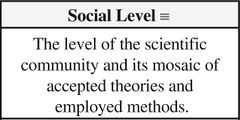Difference between revisions of "Scope of Scientonomy - Social (Barseghyan-2015)"
Paul Patton (talk | contribs) m (Reverted edits by Paul Patton (talk) to last revision by Hakob Barseghyan) |
Paul Patton (talk | contribs) (Undo revision 11953 by Paul Patton (talk)) |
||
| Line 7: | Line 7: | ||
|Authors List=Hakob Barseghyan, | |Authors List=Hakob Barseghyan, | ||
|Formulated Year=2015 | |Formulated Year=2015 | ||
| − | |Description= | + | |Description=Science is a social enterprise, but [[Scientific Community|scientific communities]] consist of individual scientists. In their daily work, individual scientists rely on and formulate [[Theory|theories]] about the object of their research, and use [[Method|methods]] to appraise their theories. Both the theories they believe and the criteria they use to assess them may change over time. Historians of science have often focused on individual scientists, often those deemed great, like Galileo or Einstein, and the changes in their beliefs as they constructed and assessed theories. |
| + | |||
| + | The [[Scientific Mosaic|scientific mosaic]] consists of those theories that have won [[Theory Acceptance|acceptance]] by a scientific community as a whole, and those methods generally [[Employed Method|employed]] in [[Theory Assessment Outcomes|theory assessment]]. The scientific mosaic of a community changes over time. Just as life depends on underlying physical and chemical processes, which are in turn constrained by their role as constituent processes of a living system, the level of the individual scientist and that of the scientific community are interrelated in a complex fashion. | ||
| + | |||
| + | |||
| + | In principle, scientonomy might focus on elucidating the mechanisms of scientific change either at the level of the community or at the level of the individual scientist. | ||
|Resource=Barseghyan (2015) | |Resource=Barseghyan (2015) | ||
| + | |Page Status=Needs Editing | ||
}} | }} | ||
{{Acceptance Record | {{Acceptance Record | ||
| Line 17: | Line 23: | ||
|Accepted From Day=1 | |Accepted From Day=1 | ||
|Accepted From Approximate=No | |Accepted From Approximate=No | ||
| + | |Acceptance Indicators=The theory was introduced by Barseghyan in ''The Laws of Scientific Change'' [[CiteRef::Barseghyan (2015)| pp. 43-51]] and became ''de facto'' accepted by the community at that time together with the whole [[The Theory of Scientific Change|theory of scientific change]]. | ||
|Still Accepted=Yes | |Still Accepted=Yes | ||
|Accepted Until Approximate=No | |Accepted Until Approximate=No | ||
}} | }} | ||
Revision as of 15:50, 6 July 2017
This is an answer to the question Scope of Scientonomy - Individual and Social that states "It is implicit in the definition of scientonomy that it should explain changes in the scientific mosaic of accepted theories and employed methods, which are changes at the level of the scientific community. It need not account for changes at the level of the beliefs of individuals."
Scope of Scientonomy - Social was formulated by Hakob Barseghyan in 2015.1 It is currently accepted by Scientonomy community as the best available answer to the question.
Contents
Scientonomic History
Acceptance Record
| Community | Accepted From | Acceptance Indicators | Still Accepted | Accepted Until | Rejection Indicators |
|---|---|---|---|---|---|
| Scientonomy | 1 January 2016 | The theory was introduced by Barseghyan in The Laws of Scientific Change pp. 43-51 and became de facto accepted by the community at that time together with the whole theory of scientific change. | Yes |
Question Answered
Scope of Scientonomy - Social (Barseghyan-2015) is an attempt to answer the following question: Ought a scientonomic theory account for changes in the mosaics of individual scientists, the mosaics of communities, or both?
See Scope of Scientonomy - Individual and Social for more details.
Description
Science is a social enterprise, but scientific communities consist of individual scientists. In their daily work, individual scientists rely on and formulate theories about the object of their research, and use methods to appraise their theories. Both the theories they believe and the criteria they use to assess them may change over time. Historians of science have often focused on individual scientists, often those deemed great, like Galileo or Einstein, and the changes in their beliefs as they constructed and assessed theories.
The scientific mosaic consists of those theories that have won acceptance by a scientific community as a whole, and those methods generally employed in theory assessment. The scientific mosaic of a community changes over time. Just as life depends on underlying physical and chemical processes, which are in turn constrained by their role as constituent processes of a living system, the level of the individual scientist and that of the scientific community are interrelated in a complex fashion.
In principle, scientonomy might focus on elucidating the mechanisms of scientific change either at the level of the community or at the level of the individual scientist.
Reasons
No reasons are indicated for this theory.
If a reason supporting this theory is missing, please add it here.
Questions About This Theory
There are no higher-order questions concerning this theory.
If a question about this theory is missing, please add it here.
References
- ^ Barseghyan, Hakob. (2015) The Laws of Scientific Change. Springer.
